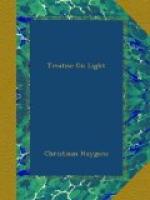According to what has been shown above, the straight line AD, which has been drawn at the summit of the sphere, at right angles to the axis parallel to which the rays come, represents the wave of light; and in the time taken by its piece D to reach the spherical surface AGE at E, its other parts will have met the same surface at F, G, H, etc., and will have also formed spherical partial waves of which these points are the centres. And the surface EK which all those waves will touch, will be the continuation of the wave AD in the sphere at the moment when the piece D has reached E. Now the line EK is not an arc of a circle, but is a curved line formed as the evolute of another curve ENC, which touches all the rays HL, GM, FO, etc., that are the refractions of the parallel rays, if we imagine laid over the convexity ENC a thread which in unwinding describes at its end E the said curve EK. For, supposing that this curve has been thus described, we will show that the said waves formed from the centres F, G, H, etc., will all touch it.
It is certain that the curve EK and all the others described by the evolution of the curve ENC, with different lengths of thread, will cut all the rays HL, GM, FO, etc., at right angles, and in such wise that the parts of them intercepted between two such curves will all be equal; for this follows from what has been demonstrated in our treatise de Motu Pendulorum. Now imagining the incident rays as being infinitely near to one another, if we consider two of them, as RG, TF, and draw GQ perpendicular to RG, and if we suppose the curve FS which intersects GM at P to have been described by evolution from the curve NC, beginning at F, as far as which the thread is supposed to extend, we may assume the small piece FP as a straight line perpendicular to the ray GM, and similarly the arc GF as a straight line. But GM being the refraction of the ray RG, and FP being perpendicular to it, QF must be to GP as 3 to 2, that is to say in the proportion of the refraction; as was shown above in explaining the discovery of Des Cartes. And the same thing occurs in all the small arcs GH, HA, etc., namely that in the quadrilaterals which enclose them the side parallel to the axis is to the opposite side as 3 to 2. Then also as 3 to 2 will the sum of the one set be to the sum of the other; that is to say, TF to AS, and DE to AK, and BE to SK or DV, supposing V to be the intersection of the curve EK and the ray FO. But, making FB perpendicular to DE, the ratio of 3 to 2 is also that of BE to the semi-diameter of the spherical wave which emanated from the point F while the light outside the transparent body traversed the space BE. Then it appears that this wave will intersect the ray FM at the same point V where it is intersected at right angles by the curve EK, and consequently that the wave will touch this curve. In the same way it can be proved that the same will apply to all the other waves above mentioned, originating at the points G, H, etc.; to wit, that they will touch the curve EK at the moment when the piece D of the wave ED shall have reached E.




